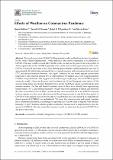| dc.contributor.author | Bukhari, Syed Qasim | |
| dc.contributor.author | Massaro, Joseph M. | |
| dc.contributor.author | D’Agostino, Ralph B. | |
| dc.contributor.author | Khan, Sheraz | |
| dc.date.accessioned | 2020-07-31T15:03:25Z | |
| dc.date.available | 2020-07-31T15:03:25Z | |
| dc.date.issued | 2020-07 | |
| dc.date.submitted | 2020-07 | |
| dc.identifier.issn | 1660-4601 | |
| dc.identifier.uri | https://hdl.handle.net/1721.1/126462 | |
| dc.description.abstract | The novel coronavirus (SARS-CoV-2) has spread globally and has been declared a pandemic by the World Health Organization. While influenza virus shows seasonality, it is unknown if COVID-19 has any weather-related affect. In this work, we analyze the patterns in local weather of all the regions affected by COVID-19 globally. Our results indicate that approximately 85% of the COVID-19 reported cases until 1 May 2020, making approximately 3 million reported cases (out of approximately 29 million tests performed) have occurred in regions with temperature between 3 and 17 °C and absolute humidity between 1 and 9 g/m3. Similarly, hot and humid regions outside these ranges have only reported around 15% or approximately 0.5 million cases (out of approximately 7 million tests performed). This suggests that weather might be playing a role in COVID-19 spread across the world. However, this role could be limited in US and European cities (above 45 N), as mean temperature and absolute humidity levels do not reach these ranges even during the peak summer months. For hot and humid countries, most of them have already been experiencing temperatures >35 °C and absolute humidity >9 g/m3 since the beginning of March, and therefore the effect of weather, however little it is, has already been accounted for in the COVID-19 spread in those regions, and they must take strict social distancing measures to stop the further spread of COVID-19. Our analysis showed that the effect of weather may have only resulted in comparatively slower spread of COVID-19, but not halted it. We found that cases in warm and humid countries have consistently increased, accounting for approximately 500,000 cases in regions with absolute humidity >9 g/m3, therefore effective public health interventions must be implemented to stop the spread of COVID-19. This also means that ‘summer’ would not alone stop the spread of COVID-19 in any part of the world. | en_US |
| dc.publisher | MDPI AG | en_US |
| dc.relation.isversionof | http://dx.doi.org/10.3390/ijerph17155399 | en_US |
| dc.rights | Creative Commons Attribution 4.0 International license | en_US |
| dc.rights.uri | https://creativecommons.org/licenses/by/4.0/ | en_US |
| dc.source | MDPI | en_US |
| dc.title | Effects of Weather on Coronavirus Pandemic | en_US |
| dc.type | Article | en_US |
| dc.identifier.citation | Bukhari, Qasim et al. "Effects of Weather on Coronavirus Pandemic." International Journal of Environmental Research and Public Health 17, 15 (July 2020): 5399 © 2020 The Authors | en_US |
| dc.contributor.department | McGovern Institute for Brain Research at MIT | en_US |
| dc.relation.journal | International Journal of Environmental Research and Public Health | en_US |
| dc.eprint.version | Final published version | en_US |
| dc.type.uri | http://purl.org/eprint/type/JournalArticle | en_US |
| eprint.status | http://purl.org/eprint/status/PeerReviewed | en_US |
| dspace.date.submission | 2020-07-31T14:30:45Z | |
| mit.journal.volume | 17 | en_US |
| mit.journal.issue | 15 | en_US |
| mit.license | PUBLISHER_CC | |
| mit.metadata.status | Complete | |
